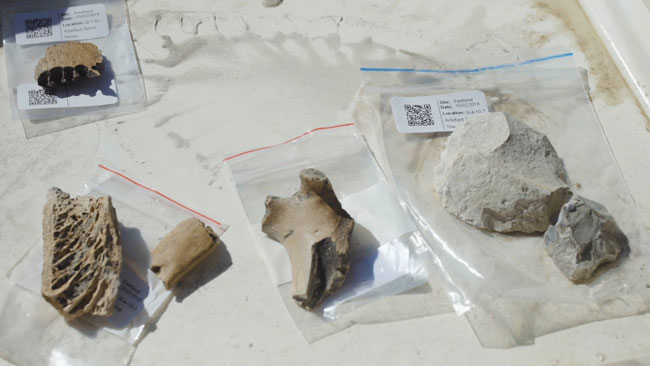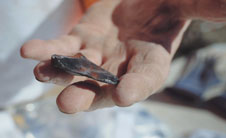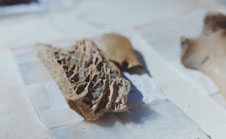 Thursday 31 May 2018 10:45am
Thursday 31 May 2018 10:45am
Bone and artefacts from the site. The bone is food remains and includes a piece of moa bone at the bottom left. The top left is part of a dog jaw. Photo: Cinema East.
A group of University of Otago archaeologists have uncovered the peripheries of a 14th century Māori village in Gisborne.
The University's Southern Pacific Archaeological Research (SPAR) unit has recently completed it's third visit to Eastland Port in Gisborne. Heritage New Zealand granted archaeological consent to the Port in 2016, as part of an ongoing redevelopment project.

An obsidian flake tool uncovered at Eastland Port. Photo: Cinema East.
Among the findings in the 2.5 metre-deep excavation were moa bones and other food items, fish hooks manufactured of moa bone and stone tools made of obsidian and chert. The site was located on the edge of an old riverbed. The obsidian (volcanic glass) was used by early Māori settlers as simple cutting tools. The materials found are estimated to date back to the early 1300s.
University of Otago Professor of Archaeology Richard Walter says uncovering the site is significant from a scientific and cultural perspective.
“We don't know as much about the early occupation around this part of the coastline as we do in other parts of the country,” says Professor Walter.
“There are not too many of these very, early sites and so this one is filling the gaps.”
The area has a significant history as the first landing place of waka (canoes) which carried Māori to the district; and the first contact between Māori and explorer James Cook taking place on the river in 1769. Plans are underway to commemorate the 250th anniversary next year.

A piece of moa leg bone that has been partly worked – probably with the intention of making a fishhook. Photo: Cinema East.
Professor Walter says given the amount of material found at the site, the chances of finding a village within the vicinity are quite high.
The site was identified through Heritage New Zealand Pouhere Taonga's archaeological consent process, which regulates the modification or destruction of archaeological sites.
“This really is a great example of the archaeological consent process working well where all the groups involved have been working together to get the best possible outcome for this very important place,” says Heritage New Zealand Pouhere Taonga's Director Regional Services Pam Bain.
Eastland Port received consent from Gisborne District Council in 2017 to develop the wharfside log yard. The site is now being re-covered with the knowledge that any ongoing redevelopments within the port will not affect the historic site.
The artefacts and faunal remains are being analysed by the SPAR team in the Otago Archaeology Laboratories in the University's Richardson Building, before the process begins to return them to their rightful owners.
A report is expected to be published on the findings at a later date.
For more information, contact:
Matiu Workman
Communications Advisor (Māori)
The University of Otago
021 279 9139
03 479 9139
Email matiu.workman@otago.ac.nz
Hayley Redpath
Communications Coordinator
Eastland Port
Email Hayley.Redpath@eastland.nz
Pam Bain
Director, Regional Services
Tel 04 470 8055
Email PBain@heritage.org.nz
A list of Otago experts available for media comment is available elsewhere on this website.
Electronic addresses (including email accounts, instant messaging services, or telephone accounts) published on this page are for the sole purpose of contact with the individuals concerned, in their capacity as officers, employees or students of the University of Otago, or their respective organisation. Publication of any such electronic address is not to be taken as consent to receive unsolicited commercial electronic messages by the address holder.
